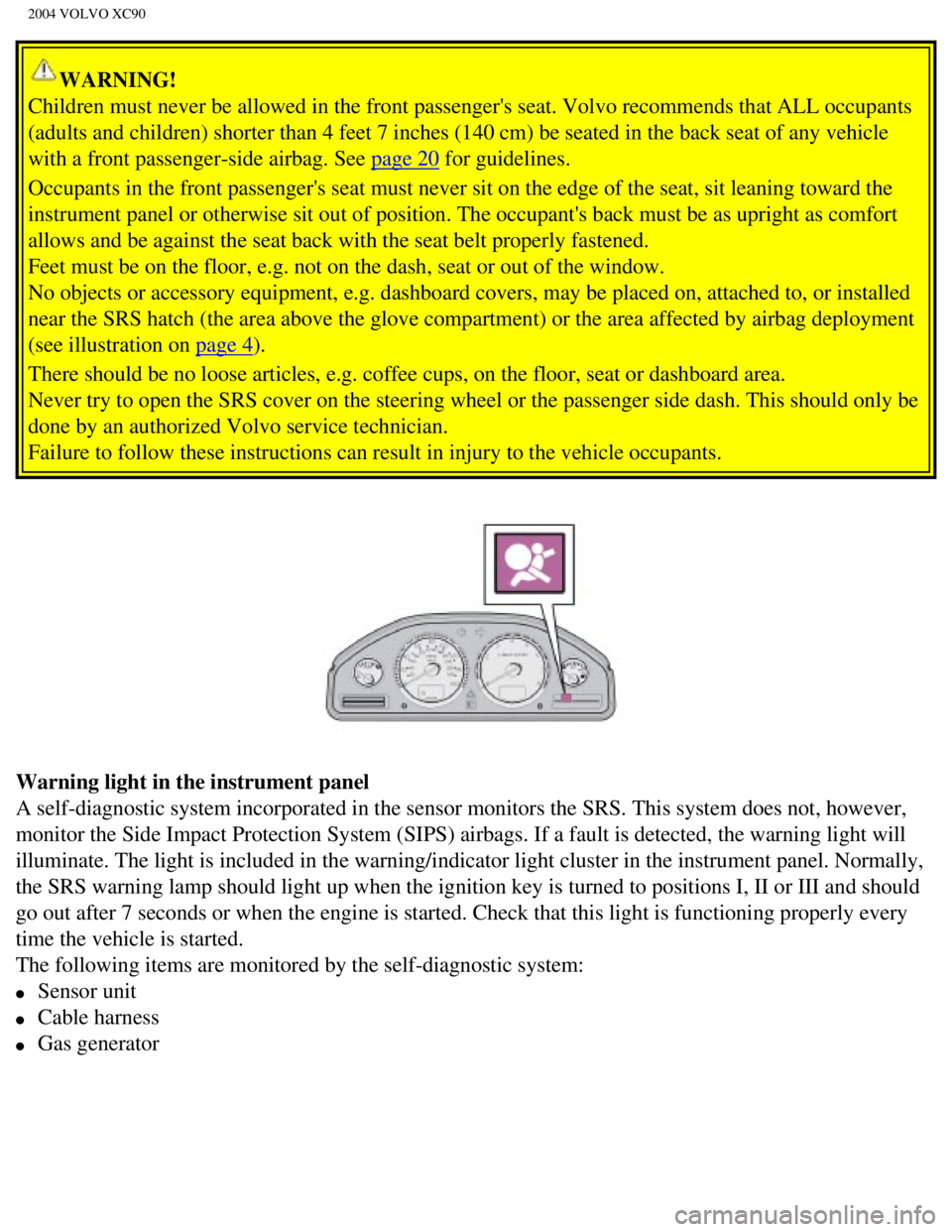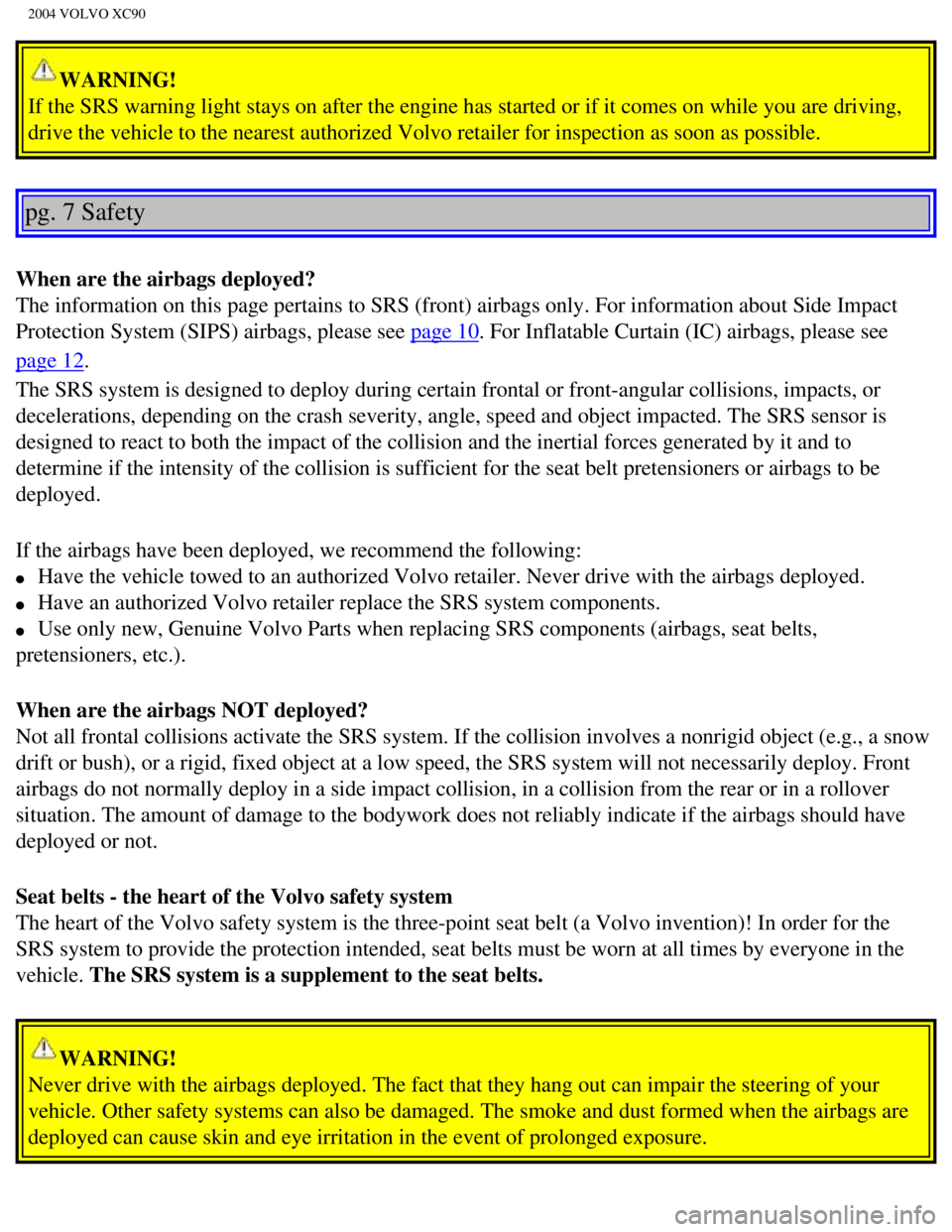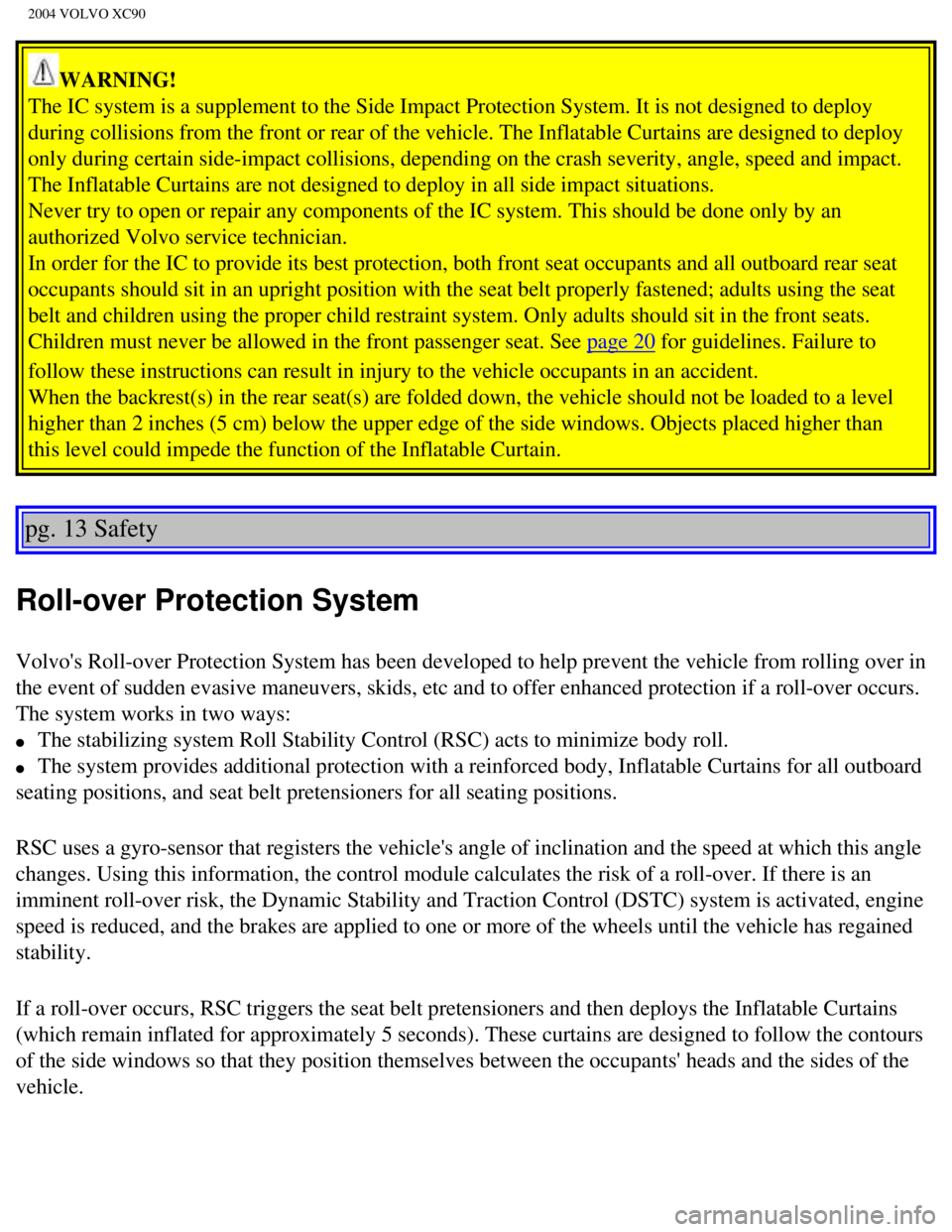sensor VOLVO XC90 2004 Owners Manual
[x] Cancel search | Manufacturer: VOLVO, Model Year: 2004, Model line: XC90, Model: VOLVO XC90 2004Pages: 245, PDF Size: 6.36 MB
Page 4 of 245

2004 VOLVO XC90
In production, Volvo has partly or completely phased out several chemica\
ls including chloro-fluorocarbons
(CFCs), lead chromates, naphtanates, asbestos, mercury and cadmium; an\
d reduced the amount of chemicals
used in our plants 50% since 1991.
Volvo was the first in the world to introduce into production a three-wa\
y catalytic converter with Lambda
Sond, now called oxygen sensor, in 1976. The current version of this hig\
hly efficient system reduces emissions
of harmful substances (CO, HC, NOx) from the exhaust pipe by approxima\
tely 95% and the search to eliminate
the remaining emissions continues. Volvo is the only automobile manufact\
urer to offer CFC-free retrofit kits
for the air conditioning system of all models as far back as the 1975 Vo\
lvo 240. Advanced electronic engine
controls, refined purification systems and cleaner fuels are bringing us\
closer to our goal.
After Volvo vehicles and parts have fulfilled their use, recycling is th\
e next critical step in completing the life
cycle. The metal content is about 75% of the total weight of a vehicle, \
which makes the vehicle among the most
recycled industrial products. In order to have efficient and well contro\
lled recycling, many Volvo variants have
printed dismantling manuals, indicating the weight and material of indiv\
idual components. For Volvo, all
homogeneous plastic parts weighing more than 1.7 oz. (50 grams) are ma\
rked with international symbols that
indicate how the component is to be sorted for recycling.
In addition to continuous environmental refinement of conventional gasol\
ine-powered internal combustion
engines, Volvo is actively looking at advanced technology alternative-fu\
el vehicles.
When you drive a Volvo, you become our partner in the work to lessen the\
car's impact on the environment.
To reduce your vehicle's environmental impact, you can:
l Maintain proper air pressure in your tires. Tests have shown decreased f\
uel economy with improperly
inflated tires.
l Follow the recommended maintenance schedule in your Warranty and Service\
Records Information booklet.
l Drive at a constant speed.
l See an authorized Volvo retailer as soon as possible for inspection if t\
he check engine (malfunction
indicator) lamp illuminates, or stays on after the vehicle has started.\
l Properly dispose of any vehicle-related waste such as used motor oil, us\
ed batteries, brake pads, etc.
l When cleaning your car, use Volvo's own car care products, all of which \
have systematically been adapted to
the environment.
For additional information regarding the environmental activities in whi\
ch Volvo Cars of North America, LLC.
and Volvo Car Corporation are involved, visit our Internet Home Page at:\
http://www.volvocars.com
PremAir®
On the surface of the radiator in the engine compartment, there is a spe\
cial coating called PremAir®. PremAir®
works as a catalytic converter, converting most of the ground-level ozon\
e passing through the radiator into
oxygen, thereby reducing harmful ground-level ozone.
file:///K|/ownersdocs/2004/2004_XC90/04xc90_00.htm (4 of 7)12/30/2006 \
4:35:10 PM
Page 14 of 245

2004 VOLVO XC90
NOTE:
Deployment of SRS components occurs only one time during an accident. In\
a collision where
deployment occurs, the airbags and seat belt pretensioners activate. Som\
e noise occurs and a small
amount of powder is released. The release of the powder may appear as sm\
oke-like matter. This is a
normal characteristic and does not indicate fire.
NOTE:
Volvo's dual-threshold, dual-stage airbags use special sensors that are \
integrated with the front seat
buckles. The point at which the airbag deploys is determined by whether \
or not the seat belt is being
used, as well as the severity of the collision. Collisions can occur whe\
re only one of the airbags deploys.
If the impact is less severe, but severe enough to present a clear injur\
y risk, the dual-stage airbags are
triggered at 70% of their total capacity. If the impact is more severe, \
the dual-stage airbags are triggered
at full capacity.
WARNING!
Do not use child safety seats or child booster cushions/backrests in the\
front passenger's seat. We also
recommend that occupants under 4 feet 7 inches (140 cm) in height who \
have outgrown these devices
sit in the rear seat with the seat belt fastened.
Never drive with the airbags deployed. The fact that they hang out can i\
mpair the steering of your
vehicle. Other safety systems can also be damaged. The smoke and dust fo\
rmed when the airbags are
deployed can cause skin and eye irritation in the event of prolonged exp\
osure.
pg. 6 Safety
Airbags (Supplemental Restraint System) (contd)
file:///K|/ownersdocs/2004/2004_XC90/04xc90_01a.htm (7 of 12)12/30/200\
6 4:35:11 PM
Page 15 of 245

2004 VOLVO XC90
WARNING!
Children must never be allowed in the front passenger's seat. Volvo reco\
mmends that ALL occupants
(adults and children) shorter than 4 feet 7 inches (140 cm) be seate\
d in the back seat of any vehicle
with a front passenger-side airbag. See
page 20 for guidelines.
Occupants in the front passenger's seat must never sit on the edge of th\
e seat, sit leaning toward the
instrument panel or otherwise sit out of position. The occupant's back m\
ust be as upright as comfort
allows and be against the seat back with the seat belt properly fastened\
.
Feet must be on the floor, e.g. not on the dash, seat or out of the wind\
ow.
No objects or accessory equipment, e.g. dashboard covers, may be placed \
on, attached to, or installed
near the SRS hatch (the area above the glove compartment) or the area \
affected by airbag deployment
(see illustration on
page 4).
There should be no loose articles, e.g. coffee cups, on the floor, seat \
or dashboard area.
Never try to open the SRS cover on the steering wheel or the passenger s\
ide dash. This should only be
done by an authorized Volvo service technician.
Failure to follow these instructions can result in injury to the vehicle\
occupants.
Warning light in the instrument panel
A self-diagnostic system incorporated in the sensor monitors the SRS. Th\
is system does not, however,
monitor the Side Impact Protection System (SIPS) airbags. If a fault i\
s detected, the warning light will
illuminate. The light is included in the warning/indicator light cluster\
in the instrument panel. Normally,
the SRS warning lamp should light up when the ignition key is turned to \
positions I, II or III and should
go out after 7 seconds or when the engine is started. Check that this li\
ght is functioning properly every
time the vehicle is started.
The following items are monitored by the self-diagnostic system:
l Sensor unit
l Cable harness
l Gas generator
file:///K|/ownersdocs/2004/2004_XC90/04xc90_01a.htm (8 of 12)12/30/200\
6 4:35:11 PM
Page 16 of 245

2004 VOLVO XC90
WARNING!
If the SRS warning light stays on after the engine has started or if it \
comes on while you are driving,
drive the vehicle to the nearest authorized Volvo retailer for inspectio\
n as soon as possible.
pg. 7 Safety
When are the airbags deployed?
The information on this page pertains to SRS (front) airbags only. For\
information about Side Impact
Protection System (SIPS) airbags, please see
page 10. For Inflatable Curtain (IC) airbags, please see
page 12.
The SRS system is designed to deploy during certain frontal or front-ang\
ular collisions, impacts, or
decelerations, depending on the crash severity, angle, speed and object \
impacted. The SRS sensor is
designed to react to both the impact of the collision and the inertial f\
orces generated by it and to
determine if the intensity of the collision is sufficient for the seat b\
elt pretensioners or airbags to be
deployed.
If the airbags have been deployed, we recommend the following:
l Have the vehicle towed to an authorized Volvo retailer. Never drive with\
the airbags deployed.
l Have an authorized Volvo retailer replace the SRS system components.
l Use only new, Genuine Volvo Parts when replacing SRS components (airbag\
s, seat belts,
pretensioners, etc.).
When are the airbags NOT deployed?
Not all frontal collisions activate the SRS system. If the collision inv\
olves a nonrigid object (e.g., a snow
drift or bush), or a rigid, fixed object at a low speed, the SRS system\
will not necessarily deploy. Front
airbags do not normally deploy in a side impact collision, in a collisio\
n from the rear or in a rollover
situation. The amount of damage to the bodywork does not reliably indica\
te if the airbags should have
deployed or not.
Seat belts - the heart of the Volvo safety system
The heart of the Volvo safety system is the three-point seat belt (a Vo\
lvo invention)! In order for the
SRS system to provide the protection intended, seat belts must be worn a\
t all times by everyone in the
vehicle. The SRS system is a supplement to the seat belts.
WARNING!
Never drive with the airbags deployed. The fact that they hang out can i\
mpair the steering of your
vehicle. Other safety systems can also be damaged. The smoke and dust fo\
rmed when the airbags are
deployed can cause skin and eye irritation in the event of prolonged exp\
osure.
file:///K|/ownersdocs/2004/2004_XC90/04xc90_01a.htm (9 of 12)12/30/200\
6 4:35:11 PM
Page 20 of 245

2004 VOLVO XC90
pg. 10 Safety
Side airbags (SIPS airbags)
SIPS airbag*
SIPS airbag (front seats only)
As an enhancement to the structural Side Impact Protection System built \
into your vehicle, the vehicle is
also equipped with Side Impact Protection System (SIPS) airbags. The S\
IPS airbag system consists of
airbag modules built into the sides of both front seat backrests, wires \
and gas generators/sensor units
(see illustration on next page).
The SIPS airbag system is designed to help increase occupant protection \
in the event of certain side
impact collisions. The SIPS airbags are designed to deploy only during c\
ertain side-impact collisions,
depending on the crash severity, angle, speed and point of impact.
The airbags are not designed to deploy in all side impact situations.
file:///K|/ownersdocs/2004/2004_XC90/04xc90_01b.htm (1 of 16)12/30/200\
6 4:35:12 PM
Page 21 of 245

2004 VOLVO XC90
NOTE: SIPS airbag deployment (one airbag) occurs only on the side of the ve\
hicle affected by the
impact.The airbags are not designed to deploy in all side impact situati\
ons.
*A SIPS airbag warning decal is also located at the end of the instrumen\
t panel on the driver's side of the
vehicle.
WARNING!
l The SIPS airbag system is a supplement to the Side Impact Protection Sys\
tem and the three-point
seat belt system. It is not designed to deploy during collisions from th\
e front or rear of the vehicle,
and will only deploy in certain rollover situations.
l The use of seat covers on the front seats may impede SIPS airbag deploym\
ent.
l No objects, accessory equipment or stickers may be placed on, attached t\
o or installed near, the
SIPS airbag system or in the area affected by SIPS airbag deployment (s\
ee illustration above).
l Never try to open or repair any components of the SIPS airbag system. Th\
is should be done only
by an authorized Volvo service technician.
l In order for the SIPS airbag to provide its best protection, both front \
seat occupants should sit in an
upright position with the seat belt properly fastened.
l Failure to follow these instructions can result in injury to the occupan\
ts of the vehicle in the event
of an accident.
pg. 11 Safety
The SIPS airbag system
This system consists of a gas generator (1), the side airbags (2), a\
nd electronic sensors/cables (3).
pg. 12 Safety
file:///K|/ownersdocs/2004/2004_XC90/04xc90_01b.htm (2 of 16)12/30/200\
6 4:35:12 PM
Page 23 of 245

2004 VOLVO XC90
WARNING!
The IC system is a supplement to the Side Impact Protection System. It i\
s not designed to deploy
during collisions from the front or rear of the vehicle. The Inflatable \
Curtains are designed to deploy
only during certain side-impact collisions, depending on the crash sever\
ity, angle, speed and impact.
The Inflatable Curtains are not designed to deploy in all side impact si\
tuations.
Never try to open or repair any components of the IC system. This should\
be done only by an
authorized Volvo service technician.
In order for the IC to provide its best protection, both front seat occu\
pants and all outboard rear seat
occupants should sit in an upright position with the seat belt properly \
fastened; adults using the seat
belt and children using the proper child restraint system. Only adults s\
hould sit in the front seats.
Children must never be allowed in the front passenger seat. See
page 20 for guidelines. Failure to
follow these instructions can result in injury to the vehicle occupants \
in an accident.
When the backrest(s) in the rear seat(s) are folded down, the vehicl\
e should not be loaded to a level
higher than 2 inches (5 cm) below the upper edge of the side windows. \
Objects placed higher than
this level could impede the function of the Inflatable Curtain.
pg. 13 Safety
Roll-over Protection System
Volvo's Roll-over Protection System has been developed to help prevent t\
he vehicle from rolling over in
the event of sudden evasive maneuvers, skids, etc and to offer enhanced \
protection if a roll-over occurs.
The system works in two ways:
l The stabilizing system Roll Stability Control (RSC) acts to minimize b\
ody roll.
l The system provides additional protection with a reinforced body, Inflat\
able Curtains for all outboard
seating positions, and seat belt pretensioners for all seating positions\
.
RSC uses a gyro-sensor that registers the vehicle's angle of inclination\
and the speed at which this angle
changes. Using this information, the control module calculates the risk \
of a roll-over. If there is an
imminent roll-over risk, the Dynamic Stability and Traction Control (DS\
TC) system is activated, engine
speed is reduced, and the brakes are applied to one or more of the wheel\
s until the vehicle has regained
stability.
If a roll-over occurs, RSC triggers the seat belt pretensioners and then\
deploys the Inflatable Curtains
(which remain inflated for approximately 5 seconds). These curtains ar\
e designed to follow the contours
of the side windows so that they position themselves between the occupan\
ts' heads and the sides of the
vehicle.
file:///K|/ownersdocs/2004/2004_XC90/04xc90_01b.htm (4 of 16)12/30/200\
6 4:35:12 PM
Page 45 of 245

2004 VOLVO XC90
5. Rear seat air conditioning (option)
This button controls the optional rear seat air conditioning system on s\
even-seat models.
6. Temporarily disconnecting the alarm sensors (option)
See
page 79 for more details.
7. Not in use
8. 12 volt socket
This 12 volt socket can be used to plug in certain accessories such as c\
ellular telephones, etc. The
ignition key must be in position 1 (or higher) for the auxiliary socke\
t to function.
NOTE: The auxiliary sockets can also be used for cigarette lighters, which are\
available as accessories
at your Volvo retailer.
pg. 30 Instruments and controls
Lighting panel
A - Headlights and parking lights
All lighting off.
Models with daytime running lights:
Low beam headlights will automatically come on if the ignition key is in\
position II. Front and rear
parking lights, tail lights, side marker lights, and license plate light\
s will also be on. Volvo recommends
the use of daytime running lights. If, however, you would prefer to have\
these lights turned off (USA
only), please consult your Volvo retailer. Please note that the use of \
daytime running lights is mandatory
in Canada.
NOTE: Bi-Xenon headlights (option): Turn the headlight switch to position 0\
to activate a daylight
sensor, which automatically switches the low beams on or off, depending \
on ambient light conditions.
When driving in daylight, the headlights will switch off and the daytime\
running lights will come on. In
darkness, the daytime running lights will switch off and the Bi-Xenon he\
adlights will switch on.
Parking lights on. The parking lights should be switched off when you leave the vehicle to \
help avoid battery drain.
file:///K|/ownersdocs/2004/2004_XC90/04xc90_02a.htm (10 of 16)12/30/20\
06 4:35:14 PM
Page 46 of 245

2004 VOLVO XC90
Headlights, parking lights, license plate lights and instrument panel il\
lumination are on if the
ignition key is in position II.
The headlight switch must be in this position before the high beams will\
function (this also applies on
models equipped with the optional Bi-Xenon headlights).
Switch from high to low beams and vice versa by pulling the turn signal \
switch lever on the left side of
steering column toward you.
B - Instrument lighting
Move the thumb wheel up to increase brightness or down to decrease brigh\
tness. There is also an
instrument panel illumination sensor (see illustration on
page 46) which automatically adjusts the level
of illumination. The symbols have maximum illumination in daylight (onl\
y the background lighting can
be adjusted). At night, both the symbol light and background lighting c\
an be adjusted.
C - Unlocking the fuel filler door
Press this button when the vehicle is at a standstill to unlock the fuel\
filler door. Please note that the fuel
filler door will remain unlocked until the vehicle begins to move forwar\
d. An audible click will be heard
when the fuel filler door relocks. See also
page 84.
NOTE: If the fuel filler door does not unlock after the button has been press\
ed, please see
page 31 for
information on manually unlocking this door.
D - Front fog lights
The front fog lights will function only in combination with the low beam\
headlights. The fog lights turn
off when the ignition is switched off.
A light in the switch indicates when the front fog lights are on.
file:///K|/ownersdocs/2004/2004_XC90/04xc90_02a.htm (11 of 16)12/30/20\
06 4:35:14 PM
Page 50 of 245

2004 VOLVO XC90
WARNING!
The Never adjust the steering wheel while
driving.
pg. 33 Instruments and controls
Windshield wipers
Windshield wipers off
If the lever is in the 0 position and you move it upwards, the wipers wi\
ll sweep one stroke at a time for
as long as you hold the lever up.
"Single sweep" position
Move the lever slightly upward from the 0 position for one sweep of the \
wipers. The lever return
automatically to 0 when released.
Intermittent wiper function
With the lever in this position, you can set the wiper interval by twist\
ing the control ring (A) upward to
increase wiper speed or downward to decrease the speed.
Rain sensor (option)
The rain sensor replaces the intermittent wiper function and automatical\
ly regulates wiper speed
according to the amount of water on the windshield. The sensitivity of the sensor can be adjusted by
twisting collar A upward or downward.
file:///K|/ownersdocs/2004/2004_XC90/04xc90_02a.htm (15 of 16)12/30/20\
06 4:35:14 PM